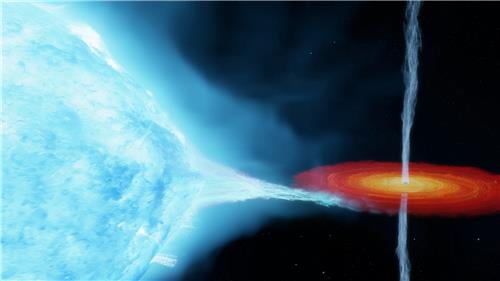International joint research team such as Cheon Mun-yeon, precise measurement of the location and mass of X-1 Cygnus
VLBA telescope measurement results “7,200 light-years from Earth, 21 times the mass of the Sun”

The black hole first discovered by mankind has been identified as being farther away and heavier than previously known.
The international joint research team, which the Korea Astronomy Research Institute participated in, announced on the 19th that it has succeeded in measuring the precise location of the X-1 Cygnus black hole using a U.S. ultra-long-air interferometer (VLBA) telescope connected to 10 radio telescopes.
The first black hole X-1 Cygnus discovered in 1964 is an X-ray hull.
The black hole and its companion blue supergiant (stars that emit high energy with a mass of up to 100 times that of the Sun and a luminosity of up to 1 million times of the Sun) form a binary system and orbit each other every 5.6 days.

The blue supergiant material flows into a black hole with a strong gravitational field, which rapidly rotates around the black hole and emits powerful X-rays.
The research team observed radio signals from the black hole X-1 Cygnus, while using a triangular parallax method to precisely measure the distance from Earth.

As a result, the distance from Earth to the black hole X-1 Cygnus was 7,200 light-years, farther than 6,100 light-years previously known.
It has been found that the black hole has a mass of 21 times the Sun, 50% heavier than previously known.
The X-1 Cygnus black hole is a’star mass black hole’ that is born at the end of the star’s evolution, and is expected to contribute to clarifying the growth process from the evolution of heavy stars to black holes.
“Considering that the mass was much heavier than the previous hypothesis, the mass loss would have been relatively small in the evolutionary process,” said co-author of the study, Ilya Mandel, a professor at Monash University in Australia. “It is likely that a star that was 60 times the mass of the Sun a year ago would have collapsed.”
Dr. Tae-Hyun Cheon said, “We plan to continue research on X-3 Cygnus, a subsequent black hole using the Korea Space Radio Observation Network (KVN), which is the only one in the world that can simultaneously observe four frequency bands.”
The results of this study were published on the eve of the prestigious international journal’Science’.
/yunhap news
Ⓒ Hankyung.com prohibits unauthorized reproduction and redistribution
